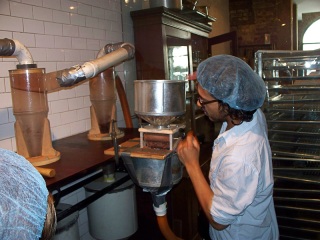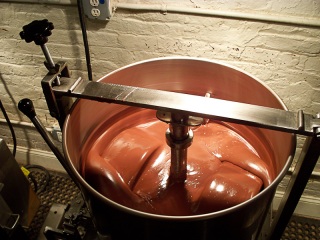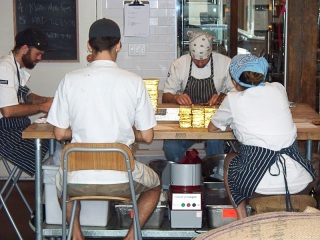They then had someone handcraft a machine that would accomplish the next step of, cracking the beans and removing the husky outer shell. The roasted beans are poured into a hopper where they drop down into several hand-cranked rollers that crack the bean and release the “nib,†the heart of the cocoa bean.
Based on the centuries-old tradition of tossing cracked wheat into the air and allowing the wind to take away the unusable chaff thereby reserving the heavier kernel, instead of wind they use a simple vacuum which helps separate the nib from the husk and deposit them into containers.
The nibs are then “conched†(heated and ground) for 3 days so the chocolate is brilliantly smooth.  Most companies extract the cocoa butter and then add it back, along with other additives-Mast Brothers do no such thing! After the chocolate has been conched, the chocolate is then tempered (brought to a specific and ideal temperature) for appearance and consistency.
Only sugar and perhaps a defining ingredient for the bar are added (such as Serrano chili, which is a new bar flavor). Â Then they are wrapped by hand in golden foil by the team.
Our visit concluded with a tasting of many of the Mast Brothers chocolate bars, including the new Grand Cru from Venezuela (a spicy, almost autumnal flavor with top notes of cinnamon)Â decorated in a distinctive new teal floral paper.
We were also inspired to hear about “Sail Freight.† A non-profit expedition to sail cocoa beans back from the Dominican Republic without using any fossil fuels next spring, and to create a documentary about the entire experience.  You can see Karen listening to Connor, captivated by his tales of the sea and the anticipation of this great journey.






